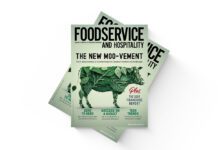A love of food may initially attract a person to the restaurant industry, but without a love of people, they are unlikely to remain. Those who do remain and rise through the ranks must possess a knack for managing and motivating diverse groups in high-pressure situations. When it comes to the challenges associated with running a restaurant, people and food are two sides of the same coin.
“We get gratification, as chefs, making people happy through food,” says John Jackson, co-owner and co-executive chef of Charcut Roast House and Charbar in Calgary. When asked which issue he, as a restaurant owner, spends more time thinking about, he replies: “I don’t think you
can think about one and not the other. It’s intertwined.”
Jackson is half of a well-known professional partnership with Top Chef Canada finalist Connie DeSousa. He says their unique dynamic lends itself to a supportive kitchen culture.
“I was actually Connie’s chef and she was my apprentice in 1999 and now we’re business partners and co-chefs. And that’s been the philosophy of our business. That’s not to say that all the people in our business will become owners but we do look for ways to help support them to achieve their full potential. We give them the tools. It’s not about working people to death; it’s about all of us looking for a balanced workplace.”
The restaurant industry is Canada’s fourth-largest employer, directly employing 1.2 million people or 6.9 per cent of the total workforce. Working in a restaurant is also the most popular first job — 22 per cent of Canadians got their start in the foodservice industry. “An average of 31.5 per cent of gross sales go toward labour costs,” explains Donna Dooher, president and CEO of Restaurants Canada in Toronto.
According to Restaurants Canada, Canadian restaurants employ 512,200 people under 25 years of age, accounting for one in five youth jobs. “One of the things about our industry is that we are geared to youth,” says Dooher. “We’re one of the largest employers of youth in all the sectors.”
But restaurants need to adjust their corporate culture to catch up with millennial workers, who now comprise the largest generational contingent of the Canadian workforce (36.8 per cent in 2015 according to Statistics Canada). The “Deloitte Millennial Survey 2016” shows this demographic is fickle, unless your business aligns with their values. A total of 66 per cent expect to leave their current employer by the end of 2016, in part because 63 per cent believe their leadership skills are not being fully developed. Millennials want to feel they are progressing in their careers. Therefore, an emphasis on professional development, ongoing training and progressively increasing responsibility will entice them to stay, the study recommends.
The study also shows that when it comes to choosing an employer, the number-1 factor (excluding salary) is work-life balance, followed by opportunities to progress/lead, flexibility, sense of meaning and professional development training programs. In an industry where 10-, 12- and even 14-hour days are common, millennial workers are not the only demographic craving more balance. Innovative restaurants such as Model Milk and Pigeonhole in Calgary and Enoteca Sociale in Toronto are currently experimenting with condensed four-day workweeks in order to reduce the strain and offer employees greater freedom.
“I came up as a line cook and if you’re working at a certain level the expectations are that you will work long hours and late nights,” says chef Kris Schlotzhauer of Enoteca Sociale. “Being in a position where I can hopefully influence my staff, I tried to think of ways to reduce their workload. I racked my brain and a four-day workweek where they are still able to work those 10, 11-hour shifts seemed to be the best solution for them, as well as from a business standpoint.”
Enoteca Sociale has been working with this model since October, and Schlotzhauer says it’s been amazing. “We really haven’t seen a spike in our labour costs, because we made it clear from the get-go that this was a team effort. We were going to do our part but the cooks can’t be going into overtime every week because that’s when things get really hairy from a business standpoint. They’ve been really good about making sure they are capping at 44 hours a week — hustling and being productive in the time that they are here.”
Threats on the horizon
Beyond cultural concerns, perhaps the greatest challenge facing restaurants today is the threat of government-mandated changes that could push labour costs past the breaking point. Alberta Premier Rachel Notley’s NDP government was elected, in part, based on a pledge to increase minimum wage from $10.75 to $15 per hour by 2018. Of all Canadians earning minimum wage, 49 per cent are between 15 and 19 years old.
The Ontario Retirement Pension Plan (ORPP) will, if enacted as planned by the current government, cost restaurant industry owners in the province an extra $78 million in payroll taxes annually, according to Restaurants Canada. “I don’t think the government has done their due diligence on the uniqueness of our industry and how this will impact jobs,” says Dooher. “At the end of the day, we still want to be able to contribute to the job market, to young people who are getting their first taste of a work experience. But if the pressure continues on labour like it has, at the end of the day an operator may look at that 31.5 per cent [labour cost] and say, ‘In order for me to continue with business, I’m going to have to cut back on jobs.’”
Volume 49, Number 1
Story By: Sarah Maclean


















